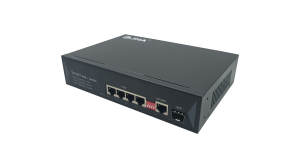PoE switch is a widely used device in the security industry today, because it is a switch that provides power and data transmission for remote switches (such as IP phones or cameras), and plays a very important role. When using PoE switches, some PoE switches are marked with PoE, and some are marked with PoE+. So, what is the difference between a PoE switch and PoE+?
1. What is a PoE switch
PoE switches are defined by the IEEE 802.3af standard and can provide up to 15.4W of DC power per port.
2. Why use a PoE switch
Over the past few decades, it was common for businesses to lay two separate wired networks, one for power and the other for data. However, this added complexity to maintenance. To address this, the introduction of PoE switch. However, as the power demands of complex and advanced systems such as IP networks, VoIP, and surveillance change, PoE switches have become an essential part of enterprises and data centers.
3. What is POE+ switch
With the development of PoE technology, a new IEEE 802.3at standard appears, called PoE+, and switches based on this standard are also called PoE+ switches. The main difference between 802.3af (PoE) and 802.3at (PoE+) is that PoE+ power supply devices provide almost twice as much power as PoE devices, which means that commonly deployed VoIP phones, WAPs and IP cameras will run on PoE+ ports .
4. Why do you need POE+ switches?
With the growing demand for higher power PoE switches in enterprises, devices such as VoIP phones, WLAN access points, network cameras and other devices need new switches with higher power to support, so this demand directly led to the birth of PoE+ switches.
5. Advantages of PoE+ switches
a. Higher power: PoE+ switches can provide up to 30W of power per port, while PoE switches can provide up to 15.4W of power per port. The minimum power available on the powered device for a PoE switch is 12.95W per port, while the minimum power available for a PoE+ switch is 25.5W per port.
b. Stronger compatibility: PoE and PoE+ switches allocate levels from 0-4 according to how much power is needed, and when a power supply device is connected to a power supply device, it provides its class to the power supply device so that the power supply device can provide it with the correct amount of power . Layer 1, Layer 2, and Layer 3 devices require very low, low, and moderate power consumption, respectively, while Layer 4 (PoE+) switches require a lot of power and are only compatible with PoE+ power supplies.
c. Further cost reduction: This simpler PoE+ uses standard cabling (Cat 5) to work with ordinary Ethernet interfaces, so no “new wire” is required. This means that existing network cabling infrastructure can be leveraged without the need to run high-voltage AC power or separate power connections for each embedded switch.
d. More powerful: PoE+ uses only CAT5 network cable (which has 8 internal wires, compared to 4 wires of CAT3), which reduces the possibility of impedance and reduces power consumption. In addition, PoE+ allows network administrators to provide greater functionality, such as providing new remote power diagnostics, status reporting, and power supply management (including remote power cycling of embedded switches).
In conclusion, PoE switches and PoE+ switches can power network switches such as network cameras, APs, and IP phones, and have high flexibility, high stability, and high immunity to electromagnetic interference.
Post time: Aug-23-2022






